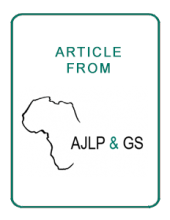/ library resources
Showing items 1 through 9 of 1361.This report synthesizes the findings from field research on land and natural resource tenure in 11 administrative clan units (henceforth referred to as „clans‟) in Liberia, including Ding, Dobli, Gbanshay, Little Kola, Mana, Motor Road, Saykleken, Tengia, Upper Workor, Ylan, and the community of
A nation formed just 10 years ago, Timor-Leste struggles to overcome complex challenges of land ownership and use rights that were created under Portuguese and Indonesian rule.
Land capital occupies a prominent place in production activities in Africa. In forestry companies, women workers of production excellence, do not enjoy the same rights as the male agent in terms of access to land.
Many cities in developing countries are experiencing urbanization characterised by the continuous proliferation of informal settlements.
Urban surface morphology is an important key factor in determining the temporal variation of thermal anisotropy.
According to a 2008 World Bank Report, Uganda is among the countries with the youngest population and the highest youth unemployment rate of 83%.
Land is the most vital resource on earth from which humankind derives almost all its basic needs. Land plays significant role through economic, social, political and cultural dimensions.
L’acquisition de larges superficies de terres arables dans les pays en développement pour y effectuer des investissements a pris forme et ampleur au Sénégal en 2000 avec l’avènement des réformes dans le secteur agricole.
This article discusses different issues pertaining gender and land governance with focus to access and control of land by rural women and how this affects their resilience in G5-Sahel region- Chad, Niger, Burkina Faso, Mali, and Mauritania.
Pagination
Land Library Search
Through our robust search engine, you can search for any item of the over 73,000 highly curated resources in the Land Library.
If you would like to find an overview of what is possible, feel free to peruse the Search Guide.


